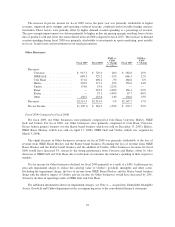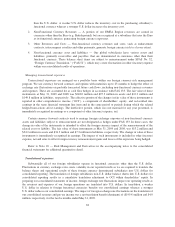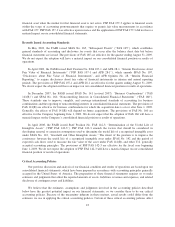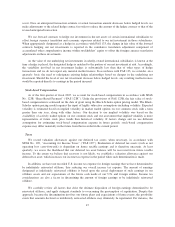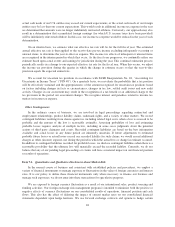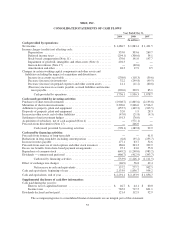Nike 2009 Annual Report Download - page 47
Download and view the complete annual report
Please find page 47 of the 2009 Nike annual report below. You can navigate through the pages in the report by either clicking on the pages listed below, or by using the keyword search tool below to find specific information within the annual report.cost of sales. If changes in market conditions result in reductions in the estimated net realizable value of our
inventory below our previous estimate, we would increase our reserve in the period in which we made such a
determination and record a charge to cost of sales.
Contingent Payments under Endorsement Contracts
A significant portion of our demand creation expense relates to payments under endorsement contracts. In
general, endorsement payments are expensed uniformly over the term of the contract. However, certain contract
elements may be accounted for differently, based upon the facts and circumstances of each individual contract.
Some of the contracts provide for contingent payments to endorsers based upon specific achievements in
their sports (e.g., winning a championship). We record selling and administrative expense for these amounts
when the endorser achieves the specific goal.
Some of the contracts provide for payments based upon endorsers maintaining a level of performance in
their sport over an extended period of time (e.g., maintaining a top ranking in a sport for a year). These amounts
are reported in selling and administrative expense when we determine that it is probable that the specified level
of performance will be maintained throughout the period. In these instances, to the extent that actual payments to
the endorser differ from our estimate due to changes in the endorser’s athletic performance, increased or
decreased selling and administrative expense may be reported in a future period.
Some of the contracts provide for royalty payments to endorsers based upon a predetermined percentage of
sales of particular products. We expense these payments in cost of sales as the related sales occur. In certain
contracts, we offer minimum guaranteed royalty payments. For contractual obligations for which we estimate
that we will not meet the minimum guaranteed amount of royalty fees through sales of product, we record the
amount of the guaranteed payment in excess of that earned through sales of product in selling and administrative
expense uniformly over the remaining guarantee period.
Property, Plant and Equipment and Definite-Lived Assets
Property, plant and equipment, including buildings, equipment, and computer hardware and software are
recorded at cost (including, in some cases, the cost of internal labor) and are depreciated over the estimated
useful life. Changes in circumstances (such as technological advances or changes to our business operations) can
result in differences between the actual and estimated useful lives. In those cases where we determine that the
useful life of a long-lived asset should be shortened, we increase depreciation expense over the remaining useful
life to depreciate the asset’s net book value to its salvage value.
We review the carrying value of long-lived assets or asset groups to be used in operations whenever events
or changes in circumstances indicate that the carrying amount of the assets might not be recoverable. Factors that
would necessitate an impairment assessment include a significant adverse change in the extent or manner in
which an asset is used, a significant adverse change in legal factors or the business climate that could affect the
value of the asset, or a significant decline in the observable market value of an asset, among others. If such facts
indicate a potential impairment, we would assess the recoverability of an asset group by determining if the
carrying value of the asset group exceeds the sum of the projected undiscounted cash flows expected to result
from the use and eventual disposition of the assets over the remaining economic life of the primary asset in the
asset group. If the recoverability test indicates that the carrying value of the asset group is not recoverable, we
will estimate the fair value of the asset group using appropriate valuation methodologies which would typically
include an estimate of discounted cash flows. Any impairment would be measured as the difference between the
asset groups carrying amount and its estimated fair value.
45


